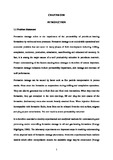| dc.description.abstract | Formation damage is an undesirable operational and economic problem that can occur in many phases of field development including drilling, completion, workover, production, stimulation, waterflooding and enhanced oil recovery. In fact, it is among the major causes of a well productivity reduction in petroleum reservoirs. Proper understanding of the factors causing these damages is therefore of utmost important.
A model for petroleum reservoir formation damage by chemical precipitation and fines migration is presented. Single type of particle (calcium carbonate) was assumed to exist in the porous system. Hydrodynamic force was modeled as the possible cause of fines mobilsation. Pore body deposition was considered as the basic
phenomenon for permeability impairment while pore throat blocking was neglected in the modeling process. Macroscopic mass balance approach was used for the particle, fluid and chemical species. A complete formation damage model was obtained by modeling different rock-fluid interactions by kinetic laws and/or empirical relations. Thomas numerical scheme was applied for the model solution using Visual Basic programming language. The simulation results were compared with existing literature data. A reasonable match was observed despite the limited literature data available.
The disagreement that was seen to exist at a later stage of the simulation between the present work and the reported literature was attributed to the omission of pore throat plugging in the model. One other factor that was believed to be the cause of this mismatch is the lack of exact correspondence in the modeling phenomena for this work and the compared literature work. However, the model was found to be a useful tool for predicting formation damage caused by inorganic deposition and fines migration during two phase flow of oil and water. In fact, it can be said with high degree of confidence that this is the first type of formation damage model that incorporated geochemical reactions and fines migration during two phase flow. | en_US |

